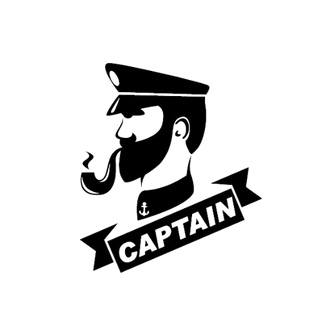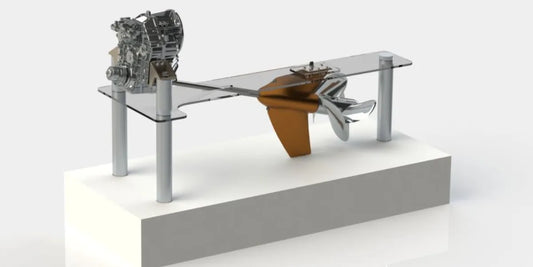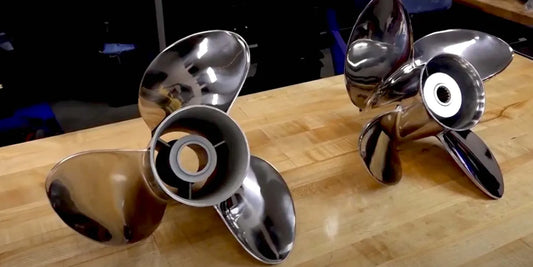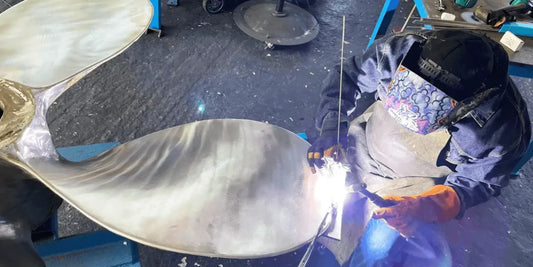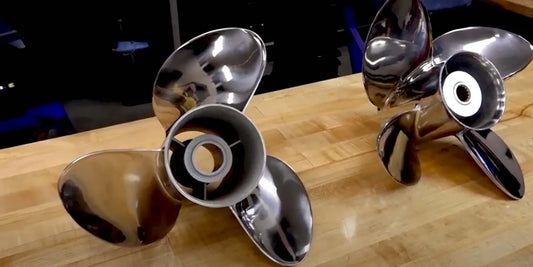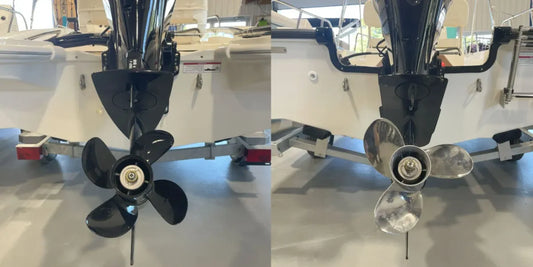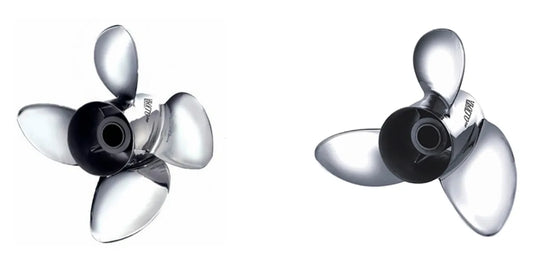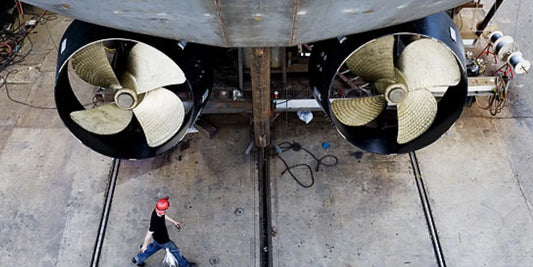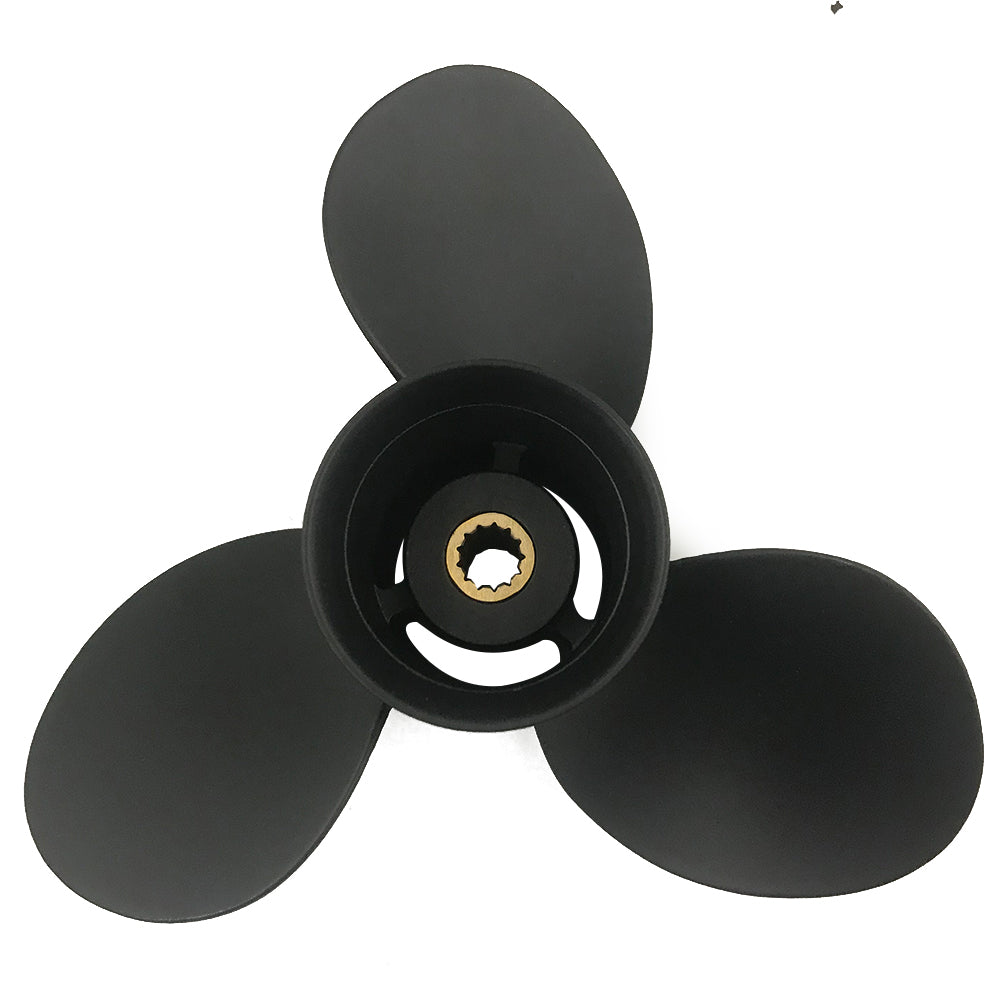When making a vital propeller choice for the boat, deciding between three or four blades may overwhelm you. Each design has various advantages affecting your vessel's performance, efficiency, and handling. Which, however, is more suitable for maximized efficiency? Whether you are looking for good fuel consumption, smoother acceleration, or top speed, knowing the differences between the two propeller types is necessary. This article looks into aspects that differentiate 3-blade propellers from 4-blade ones, allowing you to choose according to your boating requirements and preferences. Stay with us as we venture into the advantages, disadvantages, and applications, so you can be empowered with knowledge to maximize your boat's benefit.
What is the Difference Between a 3 3-blade prop and a 4 4-blade prop?

How Does the Number of Blades Affect Performance?
The number of blades on the propeller greatly determines its performance since thrust, efficiency, and handling are affected. The three-blade propeller is known to achieve higher maximum speeds because it causes less drag or friction in the water. Hence, it is preferred where speed and acceleration are significant factors in recreational boating or water racing. On the other hand, the limited blade area gives less thrust at low speeds and in heavy load situations.
Now, using the additional blade, the four-blade propellers offer the possibilities of handling, holding on to water, and stabilization to a larger degree, and hence are well suited for water sport towing or use in harsh weather conditions. Increasing blade surface area through fewer blades reduces cavitation by sharing the load, which means smooth running and greater pull capacity from this composition. Possibly, it is a compromise for some top-end speed but makes up for it by getting holeshot quicker and being more fuel-efficient in the midrange speed," which can translate into extended cruising. Knowing these performance trade-offs will help you determine the propeller for your boating needs.
What Are the Key Features of a 3-Blade Propeller?
Three blades are centered, after which a balanced design gives speed, efficiency, and thrust in equal measure. One of the important features of a 3-blade prop is that it offers greater top speed than a 4-blade prop. The top speed is increased due to reduced drag imposed by the fewer blades, giving the water an easy flow path to exert force in the process. The 3-blade propellers, in turn, are quite the all-around performers in boating activities ranging from leisure boating to sport fishing, providing reliable acceleration and completely steady performance under varying conditions.
The design of the 3-blade propeller adds to its light weight, which makes it very responsive and nimble in terms of engine agility. While those blades may not have as much "grip" in the water as the 4-blade ones, especially down at the lower speed range, the ability to use their excellent efficiency and superior maneuvering ability has put them in a class of vessels that also look at performance. Materials choices for 3-blade propellers are stainless steel and aluminum, expanding on their features; stainless steel for better durability and aluminum for lightweight and cheaper. Knowledge about these factors ensures that you can select a 3-blade propeller best suited for your particular mode of operation.
Why Choose a 4-Blade Propeller?
Four-blade propellers have superior stability and smooth operation at low RPMs or in choppy waters. An extra blade means more thrust and greater capacity for heavy-load control, implying that this is better suited for boats used for towing, fishing, or cruising, where consistent performance is imperative.
The 4-blade propeller can enhance fuel efficiency at cruising speeds by offering a better grip on the water. This propeller type also tends to reduce vibration and noise levels, making for a more comfortable ride. Steel and composite materials are among the more popular options for manufacturing 4-blade propellers, as they provide the strength and durability needed for different operating conditions. With all these attributes, 4-blade propellers are an all-around good choice for consistent and balanced performance on water.
How Does a 3-Blade vs 4-Blade Prop Impact Fuel Economy?

Is a 3-Blade Prop Better for Top Speed?
A 3-blade propeller is generally ideal for planning higher top speeds on the water because it causes less drag and more efficiency while working at high RPMs. Fewer blades, exposing less resistance to the water through a 3-blade prop, allow the propeller to accelerate and reach maximum speed. This support is added because the engine experiences less load with a 3-blade prop because of its lighter weight and lower hydrodynamic surface area, enabling the engine to work efficiently.
In reality, hull design, engine power, and other conditions all play a very significant part in overall performance. So, while a 3-blade prop certainly scores for speed, it may not have the stability or smoothness offered by a 4-blade prop, which is more handy for towing, rough waters, or enhanced maneuverability. The prop selection is a personal choice dependent on an individual's particular performance function and boating inclination.
Can a 4-Blade Prop Improve Fuel Efficiency?
A 4-blade prop could practically increase fuel economy under some conditions, especially for boats where consistent speed and enhanced stability take precedence. These props offer more lift at lower rpm, which reduces the stress on the engine and helps lower fuel consumption during constant cruising. In addition, 4-blade propellers tend to perform better in rough waters, and with their balanced design, the boat can operate effectively in a more demanding environment.
They could offer slightly lower top speeds than those of their 3-blade counterparts; nevertheless, the compromise in fuel economy and smoother operation can be advantageous when the boat is used for towing or carrying heavy loads. In comparison, using a 4-blade prop, hull shape, weight of load, and engine calibration are points to consider, because if all these are in tune with one another, the entire performance and fuel economy of the vessel can be significantly improved.
What Role Does Prop Diameter Play in Efficiency?
Prop diameter, which is the distance across the circle traced by a propeller's rotating blades, strongly affects a vessel's efficiency and performance. Theoretically, the larger this diameter, the greater volume of water will be moved, and, thus, a large-diameter propeller would be suitable for either heavy boats or for circumstances in which maximum thrust is required at low speed, like towing or negotiating strong currents. The smaller diameter prop, on the other hand, is for lightweight boats or high-speed applications, and it lessens drag and allows for quicker rotation.
It should be noted that the selection of the appropriate prop diameter will have to consider the vessel's weight, engine capacity, and how it is used. For instance, a speed-based high-performance boat would be suitable with a smaller diameter propeller and a higher pitch. In contrast, vessels laden heavily do well with large diameters to keep moving steadily at fuel-efficient speeds. In hitting a compromise, the most efficiency is generated; hence, the least strain goes on the engine, making boating enjoyable.
Which is Better for Boat Handling: 3-Blade or 4-Blade?

How Does Each Affect Low-Speed Maneuverability?
Since factors like the number of blades influence a boat's low-speed handling, a 3-blade propeller usually has less drag in the water due to the wide gaps between the blades. This means more rapid acceleration and quicker response times in shifting speeds, making it the preferred option for vessels emphasizing agility. However, this ability to respond quickly may jazz up some slight control nuances at extremely low speeds, which may become a concern while working with tight dockings or in trickier navigation scenarios.
In contrast, a 4-blade propeller has more thrust because of that extra blade, enabling it to deliver power more smoothly and consistently. This allows it the best low-speed control for boats that need to maintain position while navigating narrow channels, strong currents, etc. The extra blade also reduces vibration, allowing a smooth, repeatable feel at low speeds. While the trade-off may be fewer top-end speeds, vessels that value amenity and precision embrace this.
What About High Speed and Rough Water Conditions?
At high speed and in rough-water conditions, several critical factors influence a boat´s operation, including hull design, propulsion, and weight distribution. The streamlined shape of the hull reduces drag and allows high-speed vessels to chop through water with hardly any resistance. However, many of these hulls, particularly deep-V, are designed for performance and stability at greater speed to smooth out the ride during acceleration. Because the propulsion system admits power and thrust on fast accelerations, these are usually outboard motors or jet drives that can increase efficiency for speed.
The characteristics of rough waters offer problems that demand robust design and advanced technology. Reinforced hull structures and shock-mitigating seats are often a feature of boats working in the rougher environment to absorb impacts and offer as much comfort to passengers and crew as possible. Further, trim tabs and dynamic stabilizing systems, comprising gyroscopic stabilizers or interceptors, minimize lashings of roll and pitch due to conflicting wave action. Such features will also enhance the safety of passage, considering the steady handling provided when traversing such waters.
In the end, it takes both good design and an able skipper to cope with conditions that come with either high speed or rough waters. Modern boats, with the right design and equipment, can very well perform in demanding maritime environments while looking good in terms of comfort and safety.
What are the Effects on RPM with a 4-Blade Propeller?

How Do 4-Blade Props Change WOT?
Compared with its counterparts in 3-, 2-, and even 5-blade configurations, a 4-blade propeller presents an excellent opportunity to make Wide Open Throttle (WOT) performance improvements, increasing levels of efficiency and handling. A 4-blade propeller has greater surface area to interact with water, offering that much-needed grip. This will enhance acceleration and handling in rough water and during sharp turns. Conversely, there is a slight sacrifice in the top-end speed with the 4-blade instead of the 3-blade propeller because of the extra resistance created by its larger surface area.
One of the impacts may be the drop in maximum peak RPM of the engine at WOT due to installing the 4-blade prop. Due to the resistance generated by the design of the 4-blade, the prop may pull down the RPMs to maximum levels. Assuming 5,800 RPM with a 3-blade prop, the engine would more likely reach around 5,500 RPM with a similar 4-blade design. It becomes imperative that the prop be selected to fulfill the required conditions concerning size and pitch so that the engine operates within its optimal RPM range, avoiding being either underpowered or overworked.
Hence, for those applications requiring greater control and dependability under tough water conditions, 4-blade props, although slightly quieter, demand an even level of operational safety above that offered by 3-blade props, thus maximising their advantages in terms of stability, load carrying, and fuel economy.
Is There a Lower RPM Benefit with 4-Blade?
4-blade propellers can be considered a definite advantage in accomplishing efficiency at lower RPM. One major factor is the ability to generate thrust owing to an additional blade surface area, which increases water's gripping power. This profuse thrust capacity comes in handy in applications where the vessel may be required to run under heavy loads or maintain excellent handling even in rough conditions, for instance, fishing boats or cruisers of larger sizes.
Compared to three-blade counterparts, a four-blade propeller offers smoother operation and greater efficiency at low RPMs. For example, the increased water displacement helps reduce slippage, and, hence, the engine maintains steady and more efficient fuel consumption without sacrificing major speed. Furthermore, these props are usually built to produce greater torque, complementing performing roles such as trolling or slow cruising, where control and stability are essential.
However, the effect on RPMs also varies depending on several factors—the size and pitch of the prop and the boat's setup. Tuning the rig and selecting the best-suited prop based on boat type and performance requirements pays off with big gains in terms of 4-blade lower RPM usage.
How to Choose Between a 3 or 4-Blade Prop?

What Factors Should Be Considered for Recreational Boats?
The first thing I consider when choosing between a 3-blade and a 4-blade propeller for use in a recreational boat is how I envision using the ship. Generally, for speed and performance, like waterskiing or racing, the 3-blade prop is often the best choice because it will offer greater top speed and better fuel efficiency at high RPMs. Suppose I want quick acceleration, smoother operation, and better handling in rough water. In that case, the 4-blade will give me that advantage with its increased surface area and better grip in the water.
The size and weight of the boat are other essential considerations I always keep in mind. Large and heavy boats usually do better with 4-blade props, which magnify thrust to maximize the ability of the boat to plane efficiently. On the other hand, one of these 3- blade props will work fine for a lightly-weighted ship or one used mainly in calm conditions. Also, consider the prop pitch and diameter first- how else can the engineer manage the boat?
Last comes the choice for the type of water and conditions often faced. Four blades might give you better maneuverability and less cavitation in shallow or weedy areas. By contrast, if you think mostly about open water and swiftness, you should be okay with a three-blade prop. Ultimately, it lands on matching the prop to your particular boating needs and preferences, as well as your engine's capabilities and the overall configuration of the vessel.
How Does Boat Type Influence Your Decision?
When putting together my particular propeller, my type of boat is a significant factor in the decision-making. If I were working on a heavy, pontoon-style boat for leisure rather than speed, I would prioritize a prop that had thrust and efficient operation at very slow speeds. This ensures smooth handling in shallower waters and stability while loading multiple passengers or gear.
If I were working with a sleek speedboat for water skiing or cruising in the open, I would rather have a prop designed for higher speeds and acceleration. A light and agile hull must have a prop that stresses top-end performance and responsiveness to get the utmost from the engine. Ski boats or wakeboard boats also demand special props for quick planing and towing power, and that plays heavily into my decision.
Ultimately, the propagation of a prop depends on the type, weight, and intended purpose of the boat being used. Aligning the propeller characteristics with the boat's needs maximizes durability, yields better fuel economy, and guarantees excellent operational ease and enjoyment. It's all about understanding how my boat runs and then matching those requirements with whatever is best for the propeller setup.
When Should You Consult a Prop Shop?
One of my considerations in going to a prop shop is when I do not know the best propeller for my boat or face other performance problems beyond my capability to solve. If, for example, my boat is not attaining the highest speed, has difficulty with acceleration, or is not fuel-efficient, then an expert evaluation will determine whether my current propeller is at fault. Recommendations on changes or replacements from a prop shop will suit my particular needs.
Another instance when I have to go to a prop shop is when I am upgrading my vessel or altering its purpose. Engine power, hull design, or load capacity changes require a different propeller to achieve maximum performance. The guys in the prop shop will help me with that so we can specify the right material, pitch, and blade setup for the upgrades. Even if it is just fixing a damaged propeller, these guys can advise me if it is worth repairing or if it is better to get a new propeller.
When I go to a prop shop, I benefit from their knowledge and expertise to keep my boat performing at the top level. Their advice for diagnosing problems, upgrading, or repairs leads to an optimized experience in my boating while saving me from costly mistakes.
Reference Sources
- 3-Blade vs. 4-Blade Propeller - Michigan Wheel
- 3-Blade vs. 4-Blade Prop: What Are The Differences? - Reel Coquina Fishing
- Gas Powered Boats: 3 Blade vs 4 Blade - Bertram31
- 3-Blade vs. 4-Blade Propellers - Boatsetter
Frequently Asked Questions (FAQs)
Q: What is the main difference between a 3-blade and a 4-blade prop?
A: That said, technically, the main difference between the three and 4-blade props is their number of blades. While 3-blade props offer a higher top speed and better top-speed performance, 4-blade props, with their extra lift, can provide better handling at lower speeds, superior hole shot, and better fuel economy.
Q: What performance effects does a 4-blade propeller have on boats?
A: A 4-blade propeller considerably facilitates low-speed handling and smoothens the ride. The hole shot, which ideally suits it for water skiing or wakeboarding, an ideal short burst of speed, is greatly enhanced by a 4-blade prop. Fuel economy can be improved, too, by allowing the outboard to cruise with the optimum rpm.
Q: Compared to a 4-bladed propeller, which generally performs better for top-end speed?
A: Usually, a 3-blade prop provides better top-end speed than a 4-blade prop. This is because it cuts down drag at high speeds and is hence efficient to operate for high-speed boats.
Q: Which prop offers better hole shot performance?
A: Four-blade props excel at improving hole-shot performance. The extra blade provides added surface area to help the boat get on plane faster, which is particularly useful for heavier load-bearing boats and towing activities.
Q: How do blade numbers influence fuel efficiency?
A: The number of blades influences the fuel efficiency in a way such that 4-blade props can bring better economy as they allow the boat to cruise with lower rpms, lessening engine stress and improving the efficiency in front of a 3-blade prop.
Q: Are there other advantages of a 3-blade prop compared to a 4-blade?
A: Absolutely, a three-blade design is better for high-speed applications where top-end speed is the focus. This would also be the three-blade design that is preferable for hull designs that tend to favor less blade area to reduce drag.
Q: How do 3- and 4-blade propellers affect propeller slip?
A: Moving to a 4-blade from a 3-blade may decrease prop slip because the extra blade means better grip on the surface of the water. At low speeds, this can also lead to increased handling and control.
Q: How do the 3-blade and 4-blade propellers compare in throttle response?
A: Since a 4-blade prop will give you a smoother throttle response with more low-end torque, it is best suited for any application that needs quick acceleration. A 3-blade prop, while perhaps, offers a more aggressive throttle response at high speeds.
Q: What are the conditions to consider when selecting a 3- or 4-blade?
A: When deciding between 3 or 4 blade props, you want to take into account the type of work the boat will be doing, e.g., high speed versus towing, and hull design versus top speed versus fuel efficiency. Other considerations include the size of the boat, power of the motor, and personal choice as to which prop is right for optimum efficiency.
